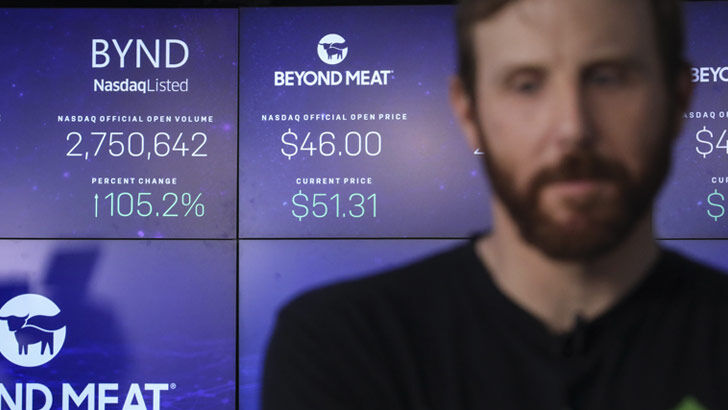Beyond investing: How to go plant-based in your portfolio
By Tom Watson
Walk into any supermarket these days and you'll most likely find a small section dedicated to alternative meat - or alternative protein - products.
"There have been phenomenal changes in a short amount of time," says Thomas King, the founder and chair of think tank Food Frontier.
Food Frontier data shows that since 2018, the number of Australian and New Zealand alternative protein companies has grown from four to more than 40 in 2023.
"There are now over 300 plant-based meat products in our supermarkets - up by a third since 2021 - with Australian and New Zealand brands making up two-thirds of the category," says King.
While not to everyone's taste, alternative protein has gained traction in recent years, with a growing number of Australians looking for substitutes for conventional meat options, whether for health or environmental reasons.
"The most recent research shows that in Australia, flexitarians are the primary consumers of plant-based meats - that is, people who largely eat plant-based meals and a smaller amount of animal protein," says King. "These Australians are drawn to plant-based proteins primarily for health reasons and secondly for sustainability."
Given the uptick in these products and interest at a consumer level, is there an opportunity for investors to get themselves a piece of the rapidly expanding plant-based protein market? And what do they need to consider before diving in?
More products on the way
Much of the alternative protein market in Australia, at least at present, is made up of products made from plants - options such as soy burger patties and pea protein sausages from brands including Beyond Meat and Impossible Foods (creators of the Impossible Burger).
As Tom King, chief investment officer at Nanuk Asset Management, explains, rather than being stock-standard vegetarian or vegan options, these products are designed to replicate the look, taste and feel of animal protein.
"I think when most people within our sphere talk about plant-based protein, they're talking about using plant protein from things like soy and pea that are converted into products that are alternatives to meat products," he says.
"That's what they're referring to - not the majority of protein that's eaten around the world that comes from plant-based sources. We all eat a lot of grains and cereals and vegetables that contain protein, but that's not what people refer to in the investment space."
One of the big questions for the sector is whether there'll be enough appetite among consumers for the new products, expected to roll out in supermarkets in the coming years.
"Research points to expected growth in the coming years," says Food Frontier's Thomas King, adding the industry is projected to be worth $3 billion by 2030.
Driving the growth, he says, is greater availability of products and the increasing range of options, coupled with people becoming more familiar with plant-based foods. "We'll see plant-based options become a norm rather than an alternative," he says. "We are also finding that governments around the world, and in Australia, are increasingly getting behind this industry to boost the diversity, security and sustainability of the food sector."
Opportunities and challenges
As with any new trend, the alternative protein sector is not without its challenges. Take one of the better-known players in the space: Los Angeles-based producer Beyond Meat.
After riding high on the back of publicity generated by its meat-like burgers, Beyond Meat became the first company of its kind in the plant-based alternative meat sector to go public in May 2019. By July of that year, its share price had rocketed up to around $US234 a share, but since then it has fallen back to around $US16. According to analysts, this is a result of consumer confusion caused by the large number of plant-based offerings, poor experiences with products and high prices.
Certainly, according to Nanuk's Tom King, one of the hurdles that companies such as Beyond Meat now face is how to lower prices to attract a greater number of customers - beyond vegans and vegetarians or those drawn to their goods by the novelty factor or environmental concerns.
"Ultimately, what the industry needs to happen to prosper in a significant way is for the cost of these products to come down to parity with meat products that they're trying to replace," he says. "And if they can get to that point, they should develop a material market share within the 'meat' category.
"It's impossible to know exactly what that might be, but if prices stay where they are, they're only going to get a couple of percentage points of that overall market," he says.
"If they can get to cost parity, let's say they might get to 10% or 15% of that broader market. If they can find a way to produce attractive products that are very cheap compared to meat, then they could end up with significantly more market share down the track, but you're a long way from seeing that happen."
Investment options
Where might investors interested in the plant-based or alternative protein sector look for exposure? Well, in terms of ASX-listed companies, there aren't many pure-play options available.
One that may fit the bill is regenerative food producer Wide Open Agriculture (ASX: WOA), which owns brands Dirty Clean Food Oat Milk and Buntine Protein (which produces plant-based protein).
Then there's Pure Foods Tasmania (PFT), which owns plant-based dairy products producer Lauds; Forbidden Foods (FFF), which sells plant-based meats under its Sensory Mill brand; and even chicken giant Inghams (ING), which has a line of plant-based protein products.

There's greater opportunity for those willing to cast their net further afield though. Among the many options are Beyond Meat (NASDAQ: BYND), ingredient provider Ingredion (NYSE: INGR) and alternative dairy producer Oatly (NASDAQ: OTLY).
Apart from holding shares in individual companies, investors can also tap into exchange traded funds (ETFs), such as the Future of Food ETF (ASX: IEAT) from BetaShares.
"The objective of the fund is to invest in the future of food," says Liddell.
"It's a portfolio of companies that are really at the forefront of food technology and food innovation. And there are some tailwinds to that investment thesis, one of which is climate change and the transition to net zero that we have to make, and the other is simply trends around population growth and the demand for food that will be necessary to feed that population."
Liddell says the fund can give investors exposure to companies in the food efficiency and production space, including French food production giant Danone (7.2%), Danish bioscience company Chr. Hansen A/S (6.6%) and US ingredient developer and producer Balchem (6.2%), which currently make up the fund's top three holdings.
Get stories like this in our newsletters.



